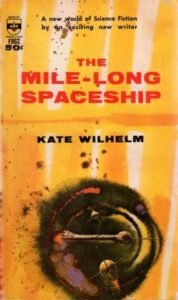The Mile-Long Spaceship by Kate Wilhelm (book review).
Kate Wilhelm’s book, ‘The Mile-Long Spaceship’ is an anthology of eleven of her short stories from the 1950s-60s.
The opening story, released in 1956, is the same as the title sans hyphen for much of the time. Mile-long spaceships weren’t new. Van Vogt introduced that size in ’The World Of Null-A’ in 1948. Quite why Wilhelm decided to do likewise but not really do much with it beats me, whereas Van Vogt treated it more like towns, which the crew preferred because going to the upper decks meant work.
For Wilhelm, a telepath on board observed a recovering injured human on Earth and induced him to learn astronavigation when he recovered. Instead, his education turned to nuclear power. I need to include a spoiler here because the ending was confusing; the captain of the spaceship decides they have failed and destroys the vessel. The logic didn’t make much sense.
When the second story also failed to make sense, it seemed like I had a dud on my hands. Then there was “Jenny With Wings,”, which caught my attention. Jenny conceals her 6-foot-sized butterfly wings, and her attempts to get a boyfriend tend to stop when they see her as a freak to exploit. However, she has a new boyfriend who she thinks is different but needs some advice from a doctor, whom she found out specialises in unusual people. Getting past a haughty nurse allows the reader to become more involved in the story and sympathise with her. The ending might not be totally unanticipated, but it was written in 1956.
‘A For Automation’, published in 1959, features a completely automated factory; however, Mike, the elderly caretaker, discovers it producing unauthorised items late at night when no one is present to supervise. Convincing his boss is a lot harder. Wilhelm was using AI before it was even called that, which is quite modern.
‘Gift From The Stars’ (1958) has a topic that still exists today where a land developer is stopped by a watchmaker who has a long-term lease. As time progresses, his efforts become increasingly risky. The strength of the story lies in the use of conventional methods to confront an unexpected challenge. Wilhelm presents the story in a conventional manner, leaving it up to you, the reader, to decipher the methods.
‘No Light In The Window’ (1963) is a preparation time for a long space flight, and two of the people involved are married with the knowledge they might not be able to go together. What is significant is that this is the first science fiction story I’ve read in which the term ‘sperm bank’ was used to describe the preservation of genetic material against damage in space. Wilhelm coined the term in the early 1960s, acknowledging its crucial role in combating ageing and radiation.
‘Andover And The Android’ (1963) shows a problem in getting along in a company when a bachelor is told he will only achieve his dreams with marriage. Andover loves his solitary life, but he has to heavily bribe a company to make him an unauthorised android wife. The company wants it back periodically for assessment, and Andover is a bit finicky about that. A nicely crafted tale should still stir you today.
The remaining stories are intriguing but less striking. Wilhelm writes elegantly but is often let down by not having strong enough endings. This doesn’t mean you shouldn’t read her, but I think her strength was in her novel-length stories.
GF Willmetts
October 2025
(pub: Berkley Medallion, 1963. 165 page paperback. Price: varies. ISBN: F882).


